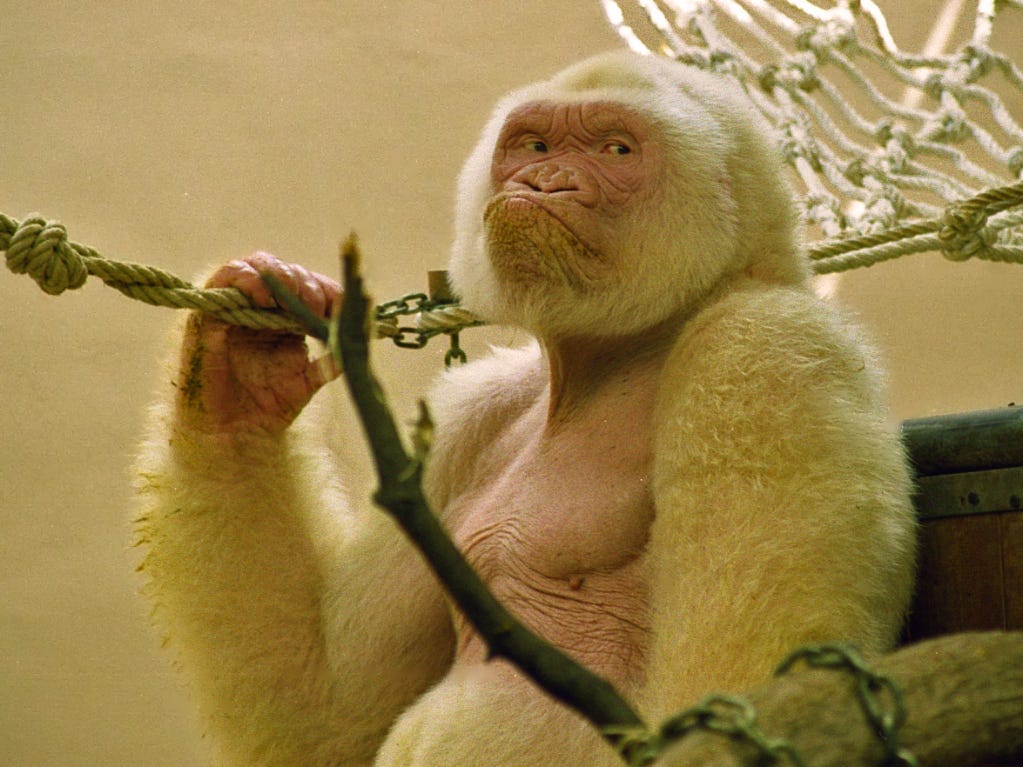
Last week marked the death of an icon of animal behavior, and I felt it appropriate to honor her. I am referring to Koko the gorilla, pictured below. Koko was a western gorilla, Gorilla gorilla, born in the San Francisco Zoo in 1974 and spent most of her life at a preserve created by the Gorilla Foundation. She is most famous for her use of a modified form of American Sign Language to communicate that was taught to her beginning at a young age (approximately 1 year old). There are still scientific disputes about the extent to which these were actual communication as compared to, for example, picking up on subtle and even unconscious clues from her handlers. This is sometimes known as the Clever Hans effect, named after a German horse in the early 1900s who could supposedly do arithmetic, but actually picked up the answers based on subtle cues of the questioner if the questioner knew the correct response (still an impressive feat of intelligence for a horse, but not as amazing as it first seemed, in fact the cues were so subtle that the psychologist who had discovered how the horse did it found it impossible to suppress them when he conducted his own demonstrations).

However, I am not interested in arguing about Koko’s sign language abilities. No matter their ultimate provenance, she was still obviously highly intelligent, even for a gorilla, which have shown tool use in the wild (such as the individual using a stick as a depth gauge below). Instead, I would like to focus on a different quirk of hers that also got wide attention, though obviously not as much as her signing. Koko had a number of pet cats.

She apparently first requested a cat in 1983, but the stuffed animal that was initially presented did not meet with her approval. She was later allowed to pick a kitten from an abandoned litter. She apparently treated the cat much like a baby gorilla, even trying to nurse him. Previously, she had spent time mimicking care for dolls, so it seemed to her keepers that her maternal instincts were beginning to progress. Her first kitten escaped and was run over after about six months and she later picked two more to care for.
However, for a long time after that she showed little interest in cats. It was hoped that this was a sign that she was done pretending and wanted the real thing, but though she lived with two other male gorillas (Michael, known for his painting, who died in 2000 and Ndume), she never had any offspring. This also meant that it would not be known if she would have tried to teach her offspring sign language.
I believe that Koko caring for young cats was less of an equivalent to what we might consider keeping pets and much more akin to a form of play, which is why it interests me. We can see, and her caregivers also picked up on, a progression of play style in Koko’s behavior. She was given dolls as toys and as a youngster would play with them in similar ways to human children. As she grew older, she progressed to wanting a living subject for her play. Various studies of mammal species have shown that play behavior tends to peak at puberty and then drop off. Female western gorillas reach maturity at 8 or 9 years of age. It may just be a coincidence that this was Koko’s age when she first made her request for a cat, or the alteration in her hormones upon reaching maturity may have triggered a change in how she played. Her earlier behavior might be classified as ‘preparatory’, but her care for kittens seems less like practicing her maternal behaviors and more like attempts to find a decent substitute. Koko seemed genuinely caring and conscientious with her surrogate young.
Play can take many forms and it can change over time. The kinds of games that you engaged in as a child may no longer hold as much interest for you later in life. This does not mean that you have lost your playfulness, merely that your life situation has changed and your play preferences reflect that change. This is natural in humans and non-human animals. In some ways, I feel that Koko’s play behavior makes her as relatable as her use of sign language. This story is my tribute to her, an animal that inspired others in much the same way that I was inspired by Myrtle the sea turtle.
We still have plenty of playful stories left in Season 6, so I hope you are still excited. Please let me know if you enjoyed this focus piece on an individual animal. I’m always interested to see which of my stories stir a reader’s imagination and this one has a slightly different style, so I would love any feedback you are willing to give. Would you like me to do more of these? Let me know in a response.